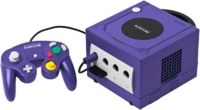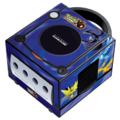Nintendo GameCube
ニンテンドーゲームキューブ Nintendo GameCube | ||||||||||||||||
 An Indigo Nintendo GameCube | ||||||||||||||||
Release dates
| ||||||||||||||||
Technical specs
| ||||||||||||||||
Related information
| ||||||||||||||||
External links
|
The Nintendo GameCube (Japanese: ニンテンドーゲームキューブ Nintendo GameCube), officially abbreviated GCN (Japanese: NGC), is Nintendo's sixth-generation console. The console was released on September 14, 2001 in Japan, November 18, 2001 in North America, May 3, 2002 in Europe, and May 17, 2002 in Australia. It is a powerful system, with a compact design, four controller ports, a controller with an ergonomic design, small but large-capacity discs, a large game library, connectivity with the Game Boy Advance with a special Game Link Cable, and a form of online play. In 2006, it was succeeded by Wii, which also features ports for most GameCube hardware as well as compatibility for its software.
A special version of the GameCube was released by Panasonic with the ability to play DVDs and audio CDs as well as GameCube games. It was named the Panasonic Q and was only available in Japan. A special GameCube edition calculator was given out to store employees at various locations selling GameCube consoles for retail use during the release of the Nintendo GameCube.
Controller
The controller for the GameCube is designed with four main buttons (A, B, X, Y, a control stick, the start button, an L and R button, Z button, a D-Pad, and a C Stick). Many versions of the controller have been released including a miniature version, one with a built-in fan, and a wireless version.
Memory
The GameCube does not have built in memory. Instead, it uses memory cards that hold the saved data in a "block" format. The user can move, copy, and delete data from the memory cards. These memory cards are needed to play GameCube games on Wii. The memory cards come with different memory capacities and are mainly made by third-party companies.
Pokémon games
| Title | Genre | Release |
|---|---|---|
| Pokémon Box Ruby & Sapphire | Utility | 2003 |
| Pokémon Channel | Virtual pet | 2003 |
| Pokémon Colosseum | RPG | 2003 |
| Pokémon XD: Gale of Darkness | RPG | 2005 |
With Game Boy Player
| Title | Genre | Release |
|---|---|---|
| Pokémon Red and Green | Main series RPG | 1996 |
| Pokémon Blue | Main series RPG | 1996 |
| Pokémon Red and Blue | Main series RPG | 1998 |
| Pokémon Yellow | Main series RPG | 1998 |
| Pokémon Trading Card Game | Card game | 1998 |
| Pokémon Pinball | Pinball | 1999 |
| Pokémon Gold and Silver | Main series RPG | 1999 |
| Pokémon Puzzle Challenge | Puzzle | 2000 |
| Pokémon Crystal | Main series RPG | 2000 |
| Pokémon Trading Card Game 2: The Invasion of Team GR! | Card game | 2001 |
| Pokémon Ruby and Sapphire | Main series RPG | 2003 |
| Pokémon Pinball: Ruby & Sapphire | Pinball | 2003 |
| Pokémon FireRed and LeafGreen | Main series RPG | 2004 |
| Pokémon Emerald | Main series RPG | 2004 |
| Pokémon Mystery Dungeon: Red Rescue Team | Dungeon crawler | 2005 |
Special Pokémon editions
A special GameCube was manufactured for Pokémon XD: Gale of Darkness. It is silver in color and features the XD logo and Shadow Lugia in place of the Nintendo GameCube logo.
In addition, a set of Pokémon XD-themed decals were available as a pre-order bonus for Pokémon XD.
Cameos
At the beginning of the 3D animated part of Pichu Bros. in Party Panic! (at the end of Part 4), Meowth is holding what appears to be a GameCube controller while at the computer.
External links
- Nintendo (Japanese)
References
| Game systems with Pokémon games |
|---|
| Nintendo handheld consoles |
| GB (Pocket · GBL · SGB · SGB2) • GBC • mini • GBA (SP · GBm · GBP) DS (Lite · DSi · DSi XL) • 3DS (XL · 2DS · New 3DS · New 3DS XL · New 2DS XL) Switch (Lite · OLED) |
| Nintendo home consoles |
| SNES (BS-X · SGB · NP · SGB2) • N64 (DD) • GCN (GBP) Wii (Family Edition · mini) • Wii U Switch (OLED) |
| Sega consoles |
| Pico • CoCoPad • Beena |




